Michigan's 14th congressional district
| Michigan's 14th congressional district | |||
|---|---|---|---|
 Michigan's 14th congressional district since January 3, 2013 | |||
| Representative |
| ||
| Population (2019) | 689,939 | ||
| Median household income | $50,438[1] | ||
| Ethnicity |
| ||
| Cook PVI | D+30[2] | ||
Michigan's 14th congressional district is a congressional district that stretches from eastern Detroit westward to Farmington Hills, then north to the suburb of Pontiac. From 2003 to 2013, it was centered in Wayne and Oakland Counties.
It is currently represented by Brenda Lawrence.[3]
According to Michigan's law on redistricting, the highest numbered district must be in the southeast corner of the state. However, despite being the highest numbered district, the 14th district is not in the southeast corner of the state; the 7th district is.[citation needed]
After the 2020 US Census Michigan's 14th district is set to be removed in the 2020 United States redistricting cycle.[4]
Future[]
The district will become obsolete as of the 2022 United States House of Representatives elections, as Michigan loses one district according to the 2020 United States census.[5]
Recent election results in statewide races[]
| Year | Office | Results |
|---|---|---|
| 1992 | President | Clinton 80% - 15% |
| 1996 | President | Clinton 86 - 11% |
| 2000 | President | Gore 81 - 18% |
| 2004 | President | Kerry 83 - 17% |
| 2008 | President | Obama 86 - 14% |
| 2012 | President | Obama 81 - 19% |
| 2016 | President | Clinton 79 - 18% |
| 2018 | Senate | Stabenow 79 - 20% |
| 2018 | Governor | Whitmer 80 - 18% |
| 2020 | President | Biden 80 - 20% |
History[]
In the 1960s, the 14th congressional district consisted of Hamtramck, the northeast portion of Detroit, Harper Woods and the Grosse Pointes. The 1964 redistricting that created these boundaries placed Lucien Nedzi, who had represented the old 14th district, in the same congressional district as fellow Democrat incumbent Harold Ryan. Nedzi was the more liberal of the two Democrats, and won the primary. In the 1972 redistricting, East Detroit and Warren south of 10 Mile Road were added to the district while some of the district in Detroit was moved to other districts. Prior to the 1972 redistricting, the majority of voters in the district were residents of Detroit. The 1972 redistricting changed the district from having a population based on the 1970 census that was 10% African American to one that was 3% African American, what with 70,000 or more residents added from East Detroit and Warren, with the latter city as a place where black families could in 1970 literally be counted with one's fingers.
At the same time, the percentage of people who were either immigrants or had at least one parent who was an immigrant fell from 46% to 37%. This was more a reflection of the fact that the residents of Warren and East Detroit at the time were in many cases literally the children and grandchildren of the residents of north-east Detroit and Hamtramck. Those born in Poland or with at least one parent born there fell from 12% to 9% of the population, the same group for Canadians fell from 7% to 6% the Italian group held steady at 6% while the German group actually rose from 4% to 6%. Since all these figures are based on the 1970 census, the changes reflect differences between the areas added and dropped, not any population movement. Based on the 1970 census, the district had the most people who identified having Belgian ancestry of any congressional district in the country, and one of the most heavily Polish as well. Based on the 1970 census, it was possible to write that Hamtramck was "an almost entirely Polish-American city".[7]
From 1982 until the 1992 redistricting, the 14th congressional district included the northeast Detroit (basically north of 6 mile and east of Ryan), Grosse Pointe Farms, Grosse Point Woods, Grosse Pointe Shores, Hamtramck, Harper Woods, the southern third of St. Clair Shores, Eastpointe, Center Line, Warren south of 10 mile and west of Van Dyke, all of Sterling Heights, Utica, Hazel Park, Madison Heights, and Troy south of about Big Beaver Road, and west of Rochester Road.[8] The district was represented by Dennis Hertel.
Conyers' 1st district included Highland Park, and Detroit between the Southfield Freeway and a line running from the south end of Highland Park over to the boundary with Dearborn. The eastern boundary of the district was with the 14th district and the northern boundary was 8 mile road.
All of the Wayne County portion of the 14th was retained in the 14th in the 1992 redistricting. It also retained most of the district area in Detroit from Conyers' old 1st district and all of Highland Park. In addition, it took in the far north-western part of Detroit and Redford Township from the 17th district, which prior to redistricting was represented by Sander Levin, and after 1992 did not exist (since there were only 16 districts). The south end of St. Clair Shores and about 80% of Eastpointe were put in the district that ended up being David Bonior's district, while the rest of Eastpointe, as well as the remaining areas in Warren, Center Line, Maidson Heights, Hazel Park, Sterling Heights, Utica and Troy were merged into the district that ended up represented by the 17th district's representative Sander Levin.
Demographic history[]
The change over time in the congressional district can be seen by what has happened in the one place that has remained constantly in the district since the 1960s, Hamtramck. Hamtramck is no longer a mainly Polish city. 20% of the population is East Indian or Bangladeshi, 19% is black or African American, and almost five percent reports multiple races. Of the 53% that is "white" according to the broad definition used by the Census, Albanians are the most numerous sub-group, with large numbers of Yemenis and Bosnians as well. It is possible that close to half the population is Muslim.[9]
The percentage of African Americans in the 2010 boundaries of the district had fallen from 61% to 59% between censuses, largely as a result of growth in the Arab population in Dearborn, combined with migration into Macomb and Oakland counties, as well as migration to Macomb, Oakland and suburban Wayne County, as well as out of Michigan entirely, from the Detroit and Highland Park portions of the district. Even the white population (including the large Arab populations in Hamtramck and Dearborn among others that rarely self-identify as white and clearly see themselves as distinct ethnic groups) within the district boundaries had declines by just over 23,000. At the same time those groups that were grouped under the heading "Asia" by the census saw their population in the district boundaries rise by a net of 2,000 during the 2010s, largely fueled by the growth of the Bangladeshi population in Hamtramck.[10]
2012 election[]
After the 2010 census, the 14th was reconfigured to take in much of eastern Detroit and the Grosse Pointes. It was also pushed westward into Oakland County to include Southfield, Farmington Hills and Pontiac. For all intents and purposes, this was the successor to the old 13th district. Meanwhile, most of the old 14th became the new 13th.
The 13th's freshman congressman, Hansen Clarke, had his home drawn into the new 13th, but opted to follow most of his constituents into the new 14th. In the Democratic primary for this hybrid urban-suburban district, Clarke faced fellow congressman Gary Peters, whose 9th district had been eliminated in redistricting, as well as Southfield mayor Brenda Lawrence and two other Democrats. Preliminary reports showed Peters, who had previously represented part of the Oakland County portion of the district, winning with 47% of the vote to Clarke's 35% and Lawrence's 13%.[11]
List of members representing the district[]
| Member | Party | Years | Cong ress |
Electoral history |
|---|---|---|---|---|
| District created March 4, 1933 | ||||
 Carl M. Weideman |
Democratic | March 4, 1933 – January 3, 1935 |
73rd | Elected in 1932. Lost renomination. |
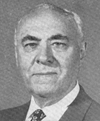 Louis C. Rabaut |
Democratic | January 3, 1935 – January 3, 1947 |
74th 75th 76th 77th 78th 79th |
Elected in 1934. Re-elected in 1936 Re-elected in 1938. Re-elected in 1940. Re-elected in 1942. Re-elected in 1944. Lost re-election. |
 Harold F. Youngblood |
Republican | January 3, 1947 – January 3, 1949 |
80th | Elected in 1946. Lost re-election. |
 Louis C. Rabaut |
Democratic | January 3, 1949 – November 12, 1961 |
81st 82nd 83rd 84th 85th 86th 87th |
Elected in 1948. Re-elected in 1950. Re-elected in 1952. Re-elected in 1954. Re-elected in 1956. Re-elected in 1958. Re-elected in 1960. Died. |
| Vacant | November 12, 1961 – February 13, 1962 |
87th | ||
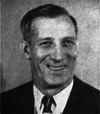 Harold M. Ryan |
Democratic | February 13, 1962 – January 3, 1965 |
87th 88th |
Elected to finish Rabaut's term. Re-elected in 1962. Lost renomination. |
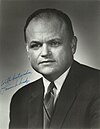 Lucien N. Nedzi |
Democratic | January 3, 1965 – January 3, 1981 |
89th 90th 91st 92nd 93rd 94th 95th 96th |
Redistricted from the 1st district and re-elected in 1964. Re-elected in 1966. Re-elected in 1968. Re-elected in 1970. Re-elected in 1972. Re-elected in 1974. Re-elected in 1976. Re-elected in 1978. Retired. |
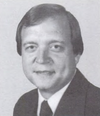 Dennis Hertel |
Democratic | January 3, 1981 – January 3, 1993 |
97th 98th 99th 100th 101st 102nd |
Elected in 1980. Re-elected in 1982. Re-elected in 1984. Re-elected in 1986. Re-elected in 1988. Re-elected in 1990. Retired. |
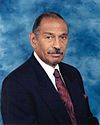 John Conyers |
Democratic | January 3, 1993 – January 3, 2013 |
103rd 104th 105th 106th 107th 108th 109th 110th 111th 112th |
Redistricted from the 1st district and re-elected in 1992. Re-elected in 1994. Re-elected in 1996. Re-elected in 1998. Re-elected in 2000. Re-elected in 2002. Re-elected in 2004. Re-elected in 2006. Re-elected in 2008. Re-elected in 2010. Redistricted to the 13th district. |
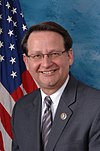 Gary Peters |
Democratic | January 3, 2013 – January 3, 2015 |
113th | Redistricted from the 9th district and re-elected in 2012. Retired to run for U.S. senator. |
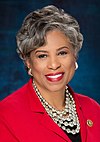 Brenda Lawrence |
Democratic | January 3, 2015 – present |
114th 115th 116th 117th |
Elected in 2014. Re-elected in 2016. Re-elected in 2018. Re-elected in 2020. |
| District to be eliminated January 3, 2023 | ||||
Recent election results[]
2012[]
| Party | Candidate | Votes | % | |
|---|---|---|---|---|
| Democratic | Gary Peters (incumbent) | 270,450 | 82.3 | |
| Republican | John Hauler | 51,395 | 15.6 | |
| Libertarian | Leonard Schwartz | 3,968 | 1.2 | |
| Green | Douglas Campbell | 2,979 | 0.9 | |
| Total votes | 328,792 | 100.0 | ||
| Democratic hold | ||||
2014[]
| Party | Candidate | Votes | % | |
|---|---|---|---|---|
| Democratic | Brenda Lawrence | 165,272 | 77.8 | |
| Republican | Christina Barr | 41,801 | 19.7 | |
| Libertarian | Leonard Schwartz | 3,366 | 1.6 | |
| Green | Stephen Boyle | 1,999 | 0.9 | |
| Independent | Calvin Pruden (write-in) | 30 | 0.0 | |
| Total votes | 212,468 | 100.0 | ||
| Democratic hold | ||||
2016[]
| Party | Candidate | Votes | % | |
|---|---|---|---|---|
| Democratic | Brenda Lawrence (incumbent) | 244,135 | 78.5 | |
| Republican | Howard Klausner | 58,103 | 18.7 | |
| Libertarian | Gregory Creswell | 4,893 | 1.6 | |
| Green | Marcia Squier | 3,843 | 1.2 | |
| Total votes | 310,974 | 100.0 | ||
| Democratic hold | ||||
2018[]
| Party | Candidate | Votes | % | |
|---|---|---|---|---|
| Democratic | Brenda Lawrence (incumbent) | 214,334 | 80.9 | |
| Republican | Marc Herschfus | 45,899 | 17.3 | |
| Working Class | Philip Kolodny | 4,761 | 1.8 | |
| Total votes | 264,994 | 100.0 | ||
| Democratic hold | ||||
2020[]
| Party | Candidate | Votes | % | |
|---|---|---|---|---|
| Democratic | Brenda Lawrence (incumbent) | 271,370 | 79.3 | |
| Republican | Robert Patrick | 62,664 | 18.3 | |
| Libertarian | Lisa Lane Gioia | 3,737 | 1.1 | |
| Working Class | Philip Kolody | 2,534 | 0.7 | |
| Green | Clyde Shabazz | 1,998 | 0.6 | |
| Total votes | 342,303 | 100.0 | ||
| Democratic hold | ||||
Historical district boundaries[]


See also[]
Notes[]
- ^ Center for New Media & Promotion (CNMP), US Census Bureau. "My Congressional District". www.census.gov.
- ^ "Partisan Voting Index – Districts of the 115th Congress" (PDF). The Cook Political Report. April 7, 2017. Retrieved April 7, 2017.
- ^ "Our District". Congresswoman Brenda Lawrence. December 4, 2012.
- ^ https://www.census.gov/library/visualizations/2021/dec/2020-apportionment-map.html
- ^ Skelley, Geoffrey (April 26, 2021). "Which States Won — And Lost — Seats In The 2020 Census?". Five Thirty Eight. Retrieved April 27, 2021.
- ^ "Previous Election Information - General Information". State of Michigan. Retrieved May 25, 2017.
- ^ Almanac of American Politics, 1980 Edition, p. 444
- ^ "Public Sector Consultants file on redistricting after the 1990 census in Michigan" (PDF). Archived from the original (PDF) on August 26, 2014. Retrieved March 1, 2012.
- ^ Based on facefinder report from United States census, along with impressions from several local news articles on Hamtramck
- ^ "Census Data".
- ^ "Detroit News 2012 primary report". Archived from the original on August 23, 2012. Retrieved August 8, 2012.
- ^ Congressional Biographical Directory of the United States 1774–present Archived April 23, 2010, at the Wayback Machine, U.S. Representatives 1837-2003, Michigan Manual 2003-2004
- ^ https://www.politico.com/2012-election/results/house/michigan
- ^ https://mielections.us/election/results/14GEN/
- ^ "2016 Michigan Election Results - Official Results". Michigan Department of State. November 8, 2016. Retrieved December 9, 2016.
- ^ Johnson, Cheryl L. (February 28, 2019). "Statistics of the Congressional Election of November 6, 2018". Clerk of the U.S. House of Representatives. Retrieved April 27, 2019.
- ^ "2020 Michigan Election Results Official". Michigan Secretary of State. Retrieved November 23, 2020.
District boundaries were redrawn in 1993, and 2003 due to reapportionment following the censuses of 1990 and 2000.
References[]
- U.S. Representatives 1837-2003, Michigan Manual 2003-2004
- Martis, Kenneth C. (1989). The Historical Atlas of Political Parties in the United States Congress. New York: Macmillan Publishing Company.
- Martis, Kenneth C. (1982). The Historical Atlas of United States Congressional Districts. New York: Macmillan Publishing Company.
- Congressional Biographical Directory of the United States 1774–present
Coordinates: 42°23′21″N 82°55′19″W / 42.38917°N 82.92194°W
- Congressional districts of Michigan
- Constituencies established in 1933
- 1933 establishments in Michigan

